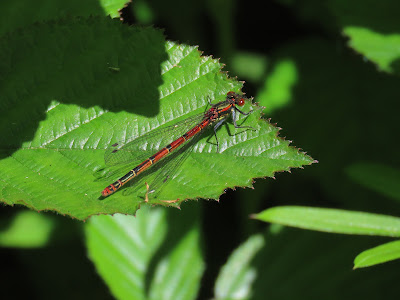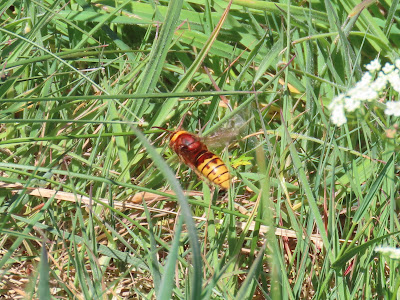I visited this area in March 2024 and it was interesting to revisit with Hull Nats during a spell of warm sunny weather. The area revisit was worth it for its botanical and insect interest. The name Cawkeld includes the word 'keld' from the Old Norse word "kelda," meaning 'spring', and caw could refer to cattle. The area includes low lying pastures with scattered boggy areas, surrounding a lake with an island, the 'Cawkeld Sinks' in the OS map, at around 10-15 m altitude. The springs converge into a drain and Kilnwick bech, which continue to Watton Beck and eventually reach the River Hull just South of Tophill Low. We start the walk at the outskirts of Kilnwick village, along a manicured broad verge and then an area of seeded meadow. The first highlight of the day was my first Painted Lady of the year. Three Swifts fly over the village.
Tuesday, 13 May 2025
Cawkeld with Hull Nats
Painted Lady.
Large Red Damselfly.
Rook.
Leaving Kilnwick we cross a couple of ditches and fields and soon we are in a low-lying pasture field, one side of it has so much Pignut. My photo below doesn't really convey it.
A bank of Pignut.
An Androchrome Azure Damselfly. There were many Azures and quite a few Large Red Damselflies.
As we stood in the pasture, a queen Horned did a few fly-passes, we were awed at the sheer size of the insect. She landed on a dead birch covered on woodpecker holes and proceeded to chew the wood. The she flew to the ground under a tussock of grass.
Queen Hornet in flight.
Green-veined White on Cuckoo Flower.
Naturalists in Cawkeld.
Chaffinch.
Poplar with Mistletoe.
Identifying sedges.
A very fresh Red Admiral on its perch in a sunny patch in the woods. It got into a spat with a Speckled Wood who coveted the same spot!
Cercopis vulnerata.
Long-tailed Tit fledgling.
A Honeybee hive on a fence...
and a close-up.
We walk along a quiet road to get back to the cars, where we have the chance to see a honeybee swarm at close range, and the scouts flying back and forth. A large ash nearby with large holes seemed a good prospect for the honeybees.
Subscribe to:
Post Comments (Atom)




















1 comment:
I’ve got a rather lovely account of a visit Alan Marshall (you may have heard of him- very active in the Hull Nats in the 80s onwards) and my husband Pete made to Cawkeld in June 1991. It it in Pete’s diary and I took a photo but can’t seem to add it here. If you could email me at wilgils@me.com I will send it to you. Jan
Post a Comment